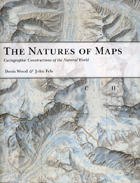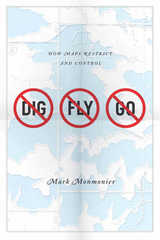4 start with N start with N

To answer that question, the authors turn to a category of maps with a particularly strong reputation for objectivity: maps of nature. From depictions of species habitats and bird migrations to portrayals of the wilds of the Grand Canyon and the reaches of the Milky Way, such maps are usually presumed—even by users who should know better—to be strictly scientific. Yet by drawing our attention to every aspect of these maps’ self-presentation, from place names to titles and legends, the authors reveal the way that each piece of information collaborates in a disguised effort to mount an argument about reality. Without our realizing it, those arguments can then come to define our very relationship to the natural world—determining whether we see ourselves as humble hikers or rampaging despoilers, participants or observers, consumers or stewards.
Richly illustrated, and crafted in vivid and witty prose, The Natures of Maps will enlighten and entertain map aficionados, scholars, and armchair navigators alike. You’ll never be able to look at Google Maps quite the same way again.

In meticulous detail, Warren E. Grabau describes the logistical situation at key junctures during the campaign and explains how and why those situations constrained the choices available to Grant and Confederate commander John C. Pemberton. Alternating between Confederate and Federal perspectives, he allows the reader to see the situation as the commanders did and then describes how the available information led to their decisions.
Grabau examines not only topographic and hydrographic features but also strategic, political, economic, and demographic factors that influenced the commanders’ thinking. He analyzes the effectiveness of the intelligence-gathering capabilities of each side, shows how the decisions of both commanders were affected by the presence of the Union Navy, and describes the impact of political philosophies and command structures on the conduct of the campaign. Through his detailed analysis, Grabau even suggests that Grant had no actual campaign plan but was instead a master opportunist, able to exploit every situation.
Remarkably detailed maps reconstruct the terrain as it was at the time and show how incomplete data often resulted in poor military decisions. Other supportive material includes Command Structures of the Federal and Confederate Forces in diagrammatic form as they stood at the beginning of the ninety-eight days.
Ninety-eight Days is a monumental work masterfully executed, a reconstruction of military reasoning that is more analytical than any previous study of Vicksburg. It contributes substantially to our understanding of those military operations and demonstrates how crucial geography is to the conduct of war.
The Author: Warren E. Grabau is a retired geologist with a long interest in the Civil War. He is he coauthor of two earlier books: Evolution of Geomorphology; A Nation-by-Nation Summary of Development (with H. J. Walker) and The Battle of Jackson, May 14, 1863 (with Edwin C. Bearss).

Some maps help us find our way; others restrict where we go and what we do. These maps control behavior, regulating activities from flying to fishing, prohibiting students from one part of town from being schooled on the other, and banishing certain individuals and industries to the periphery. This restrictive cartography has boomed in recent decades as governments seek regulate activities as diverse as hiking, building a residence, opening a store, locating a chemical plant, or painting your house anything but regulation colors. It is this aspect of mapping—its power to prohibit—that celebrated geographer Mark Monmonier tackles in No Dig, No Fly, No Go.
Rooted in ancient Egypt’s need to reestablish property boundaries following the annual retreat of the Nile’s floodwaters, restrictive mapping has been indispensable in settling the American West, claiming slices of Antarctica, protecting fragile ocean fisheries, and keeping sex offenders away from playgrounds. But it has also been used for opprobrium: during one of the darkest moments in American history, cartographic exclusion orders helped send thousands of Japanese Americans to remote detention camps. Tracing the power of prohibitive mapping at multiple levels—from regional to international—and multiple dimensions—from property to cyberspace—Monmonier demonstrates how much boundaries influence our experience—from homeownership and voting to taxation and airline travel. A worthy successor to his critically acclaimed How to Lie with Maps, the book is replete with all of the hallmarks of a Monmonier classic, including the wry observations and witty humor.
In the end, Monmonier looks far beyond the lines on the page to observe that mapped boundaries, however persuasive their appearance, are not always as permanent and impermeable as their cartographic lines might suggest. Written for anyone who votes, owns a home, or aspires to be an informed citizen, No Dig, No Fly. No Go will change the way we look at maps forever.

READERS
Browse our collection.
PUBLISHERS
See BiblioVault's publisher services.
STUDENT SERVICES
Files for college accessibility offices.
UChicago Accessibility Resources
home | accessibility | search | about | contact us
BiblioVault ® 2001 - 2024
The University of Chicago Press









